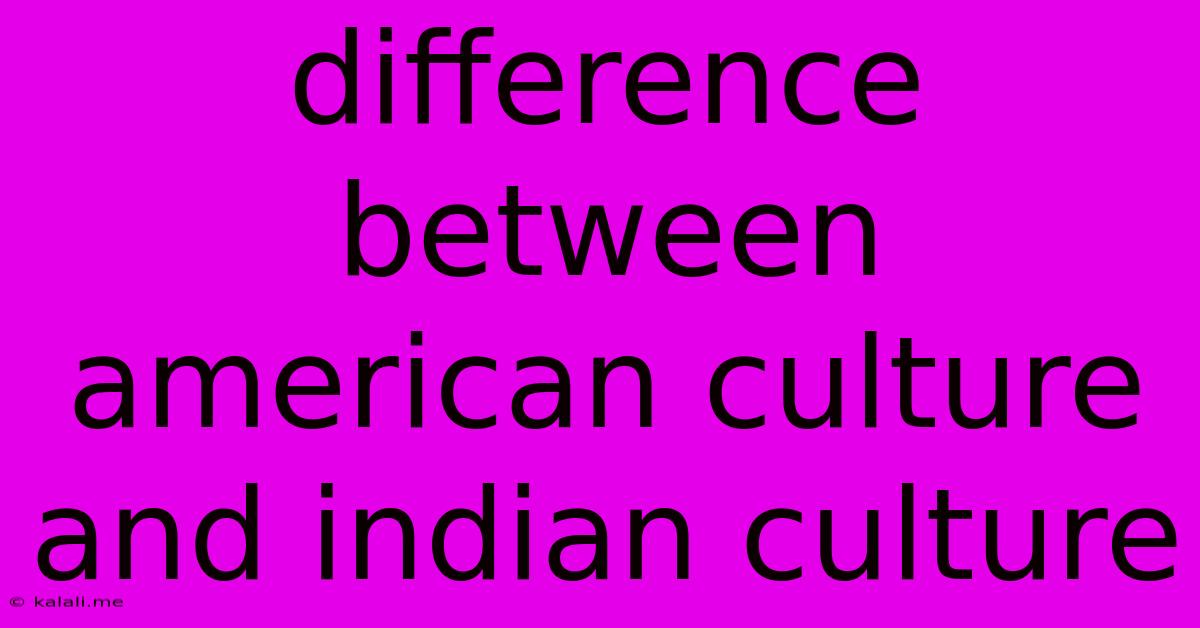Difference Between American Culture And Indian Culture
Kalali
Jun 14, 2025 · 3 min read

Table of Contents
Delving into the Differences: American vs. Indian Culture
Understanding the nuances of different cultures is crucial in today's increasingly interconnected world. This article delves into the significant differences between American and Indian cultures, exploring aspects like individualism vs. collectivism, communication styles, family structures, and religious beliefs. This comparison aims to provide a comprehensive overview, acknowledging the vast internal diversity within both nations.
Individualism vs. Collectivism: A Core Distinction
One of the most fundamental differences lies in the cultural emphasis on individualism versus collectivism. American culture, largely rooted in Western ideals, champions individualism. Personal achievement, independence, and self-reliance are highly valued. Individuals are encouraged to pursue their own goals and ambitions, often prioritizing personal needs over group harmony.
In contrast, Indian culture is deeply rooted in collectivism. Family and community ties are paramount. Decisions are often made with the best interests of the family or community in mind, prioritizing group harmony and interdependence over individual aspirations. This collectivist ethos extends to various aspects of life, from career choices to family dynamics.
Communication Styles: Direct vs. Indirect
Communication styles also differ significantly. American communication tends to be direct and explicit. People generally state their opinions openly and honestly, valuing clarity and efficiency. Indirect communication, while sometimes used, is often perceived as ambiguous or unclear.
Indian communication, on the other hand, often employs a more indirect and nuanced approach. Emphasis is placed on maintaining harmony and avoiding direct confrontation. Subtle cues, nonverbal communication, and context are crucial in understanding the intended message. Direct criticism might be considered rude or offensive.
Family Structures and Roles:
Family structures and the roles within them also contrast sharply. American families tend to be more nuclear, with emphasis on the immediate family unit (parents and children). Extended family interaction is less frequent, and individuals often move out of their parents' homes at an earlier age.
Traditional Indian families often feature a strong extended family structure, with multiple generations living together or in close proximity. Respect for elders is deeply ingrained, and their guidance and influence are highly valued in decision-making processes. Family obligations and responsibilities are shared collectively.
Religious Beliefs and Practices:
Religious beliefs and practices significantly shape cultural values and behaviors. The United States is a diverse nation with a multitude of faiths, with no single dominant religion. Religious observance varies widely depending on individual beliefs and practices.
India, conversely, displays a rich tapestry of religious traditions, with Hinduism, Islam, Sikhism, Buddhism, Jainism, and Christianity all playing significant roles. Religious practices are deeply woven into the fabric of daily life, influencing social interactions, festivals, and personal values.
Time Perception and Punctuality:
Cultural differences are also visible in perceptions of time. American culture is largely characterized by a monochronic approach to time, emphasizing punctuality, schedules, and efficiency. Being late is often viewed negatively.
Indian culture often adopts a more polychronic approach, where multiple tasks are undertaken concurrently and time is viewed as more flexible. While punctuality is appreciated, delays are often more easily accommodated due to a less rigid approach to scheduling.
Conclusion:
Understanding the vast differences between American and Indian cultures requires a nuanced approach. While these are generalizations, they highlight significant cultural contrasts impacting communication, social interaction, and personal values. Appreciating these differences fosters greater understanding, empathy, and successful cross-cultural interactions in today's globalized world. Further research into specific regional and subcultural variations within both countries provides an even richer understanding of these fascinating and complex societies.
Latest Posts
Latest Posts
-
The Speed Of A Computers Processor Is Measured In
Jun 15, 2025
-
A Solution With A Ph Of 2 Is
Jun 15, 2025
-
Is Laughter The Best Medicine Speech
Jun 15, 2025
-
Lcm Of 6 3 And 2
Jun 15, 2025
-
At What Temperature Does Water Reach Its Maximum Density
Jun 15, 2025
Related Post
Thank you for visiting our website which covers about Difference Between American Culture And Indian Culture . We hope the information provided has been useful to you. Feel free to contact us if you have any questions or need further assistance. See you next time and don't miss to bookmark.